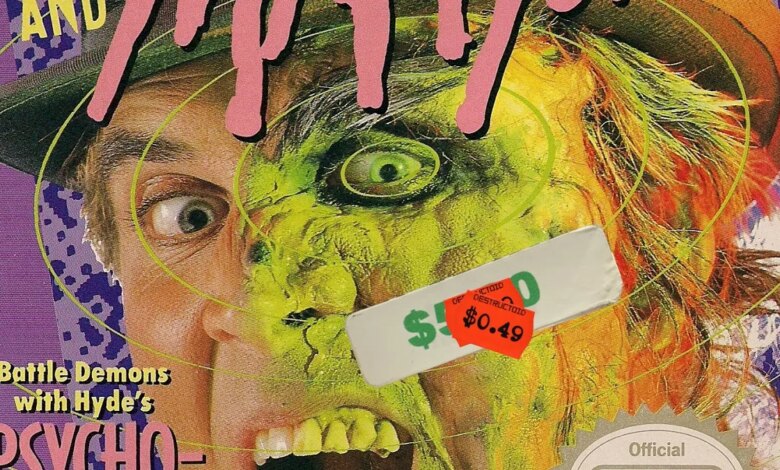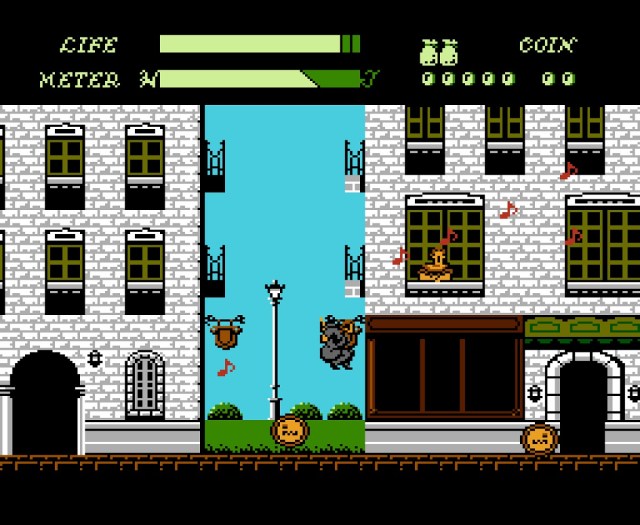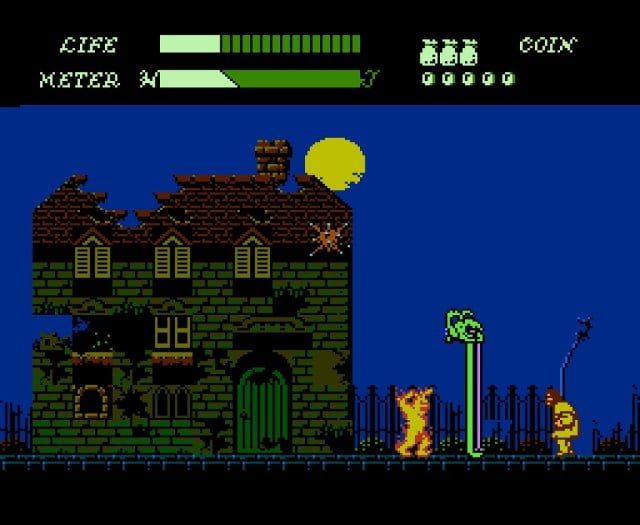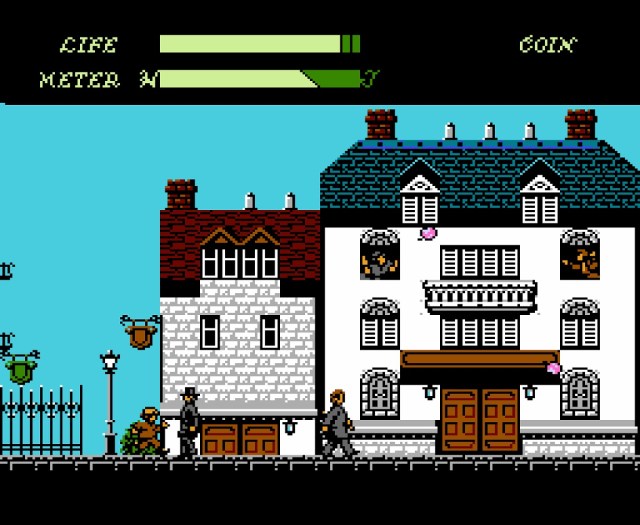Dr. Jekyll and Mr. Hyde for NES demonstrates the duality of bad and worse

When navigating the squalid wastelands of video games, I often must turn to reputation to figure out where to stick my fingers. In the West, few games have a reputation for being awful quite like Dr. Jekyll and Mr. Hyde.
This is entirely because of the Angry Video Game Nerd, who I respect but isn’t always the best source since he’s primarily aimed at providing entertainment through a schtick. Dr. Jekyll and Mr. Hyde has been singled out by him as one of the darkest spots in the NES library. I have to disagree.
Oh, it’s definitely awful. Don’t assume that I’m here to defend it. It’s as boring as a lecture on the history of terrycloth (did you know it dates back to before 4000 BCE?) and as tedious as chewing through a concrete brick. However, what you might not expect is that, when examined through autopsy, a lot of it feels very deliberate, even if many of the decisions seem misguided. A game that tries to blaze its own trail and fails is a lot more interesting than one that just ineptly follows in another’s footsteps.

Blazing its own trail
Dr. Jekyll and Mr. Hyde was created by the creatively named Advance Communication Company and released on the Famicom in 1988 as Jīkiru Hakase no Hōma ga Toki, or just Hōma ga Toki on the title screen. The full title roughly translates to Dr. Jekyll’s Hour of… something. I often see the translation of “wandering demon” or “wandering evil,” which I think is correct, but the combination of kanji seems a bit obscure.
As the name implies, the game is (very loosely) based on the 1886 novella The Strange Case of Dr. Jekyll and Mr. Hyde by Robert Louis Stevenson. The NES/Famicom didn’t really have a good track record when it came to adapting classic literature. Adventures of Tom Sawyer is the first that comes to mind, as well as Frankenstein: The Monster Returns, Ganso Saiyūki: Super Monkey Daibōken, and, the most classic of them all, Where’s Waldo? More games probably should have just gone off the deep end when it came to interpretation, like Castlevania did.
The Strange Case of Dr. Jekyll and Mr. Hyde didn’t really have a lot of action and was largely a guy trying to use science to cure himself of being a jerk. It doesn’t work, and he permanently becomes forced to say the quiet parts out loud. There are ways you could make a game around curing shame with science. Instead, Advance Communication Company made a game about a dude walking through crowded streets, trying to contain his super-powered rage.

Immersive frustration
To celebrate human duality, Dr. Jekyll and Mr. Hyde has you playing as Dr. Jekyll as you make your way across town, apparently to be wed. Along the way, he’s assaulted by birds, barrels, dogs, and dickheads. Once he’s tired of being pooped on and blown-up, he transforms into Hyde.
Hyde follows in Jekyll’s footsteps. The levels are reversed and turned into darker interpretations of themselves, and you walk to the left. Your goal as Hyde isn’t to just upend polite society with rudeness and murder. Instead, you fight monsters. As you work out your aggression by blowing up monsters, you fill up your goodness gauge and eventually turn back into Jekyll. This is narratively completely unrelated, but strangely faithful to the themes of the book.
The key to the Hyde sequences are that you’re trying to change back to Jekyll before Hyde can reach the same spot in the level where Jekyll transformed. If he passes Jekyll, he drops dead on the spot, and it’s game over.
The biggest issue with Dr. Jekyll and Mr. Hyde is that it’s based around the idea that, as Jekyll becomes frustrated with rude people and terrorists, his stress builds, eventually turning into Hyde. Advance Communication Company decided to communicate the frustration that Jekyll is experiencing by actually making the player frustrated. It’s so incredibly effective in its immersiveness.

The damage of everyday life
While you’re walking as Jekyll, you’re constantly under assault. Kids hit you with rocks from slingshots, dead birds fall on your head, and guys drop bombs at your feet. Every hit you take knocks you back about a kilometer, and there are no invincibility frames. Once you’ve made contact with something you shouldn’t, you’ll fly backward and take damage until it eventually disconnects.
What pushes this into excruciating territory is the random movements of enemies. While you can eventually memorize when and where certain foes will spawn, there’s a lot that can’t be predicted. Spiders, for example, hang from a tree, and rise and fall on a thread. In a normal game, they would rise and drop at a constant rate, but in Dr. Jekyll and Mr. Hyde they move at different speeds and to different heights on their own whim. A spider may hang unavoidably in your path for ages. Then it might slowly climb higher until you can pass under it, before quickly falling the moment you step forward. This will, again, bounce you backward a few meters. You can’t just brute force your way through.
This isn’t so bad with birds and slingshot kids. They launch a projectile that does move at a consistent speed that you can react to. However, there are singing ladies who will spew musical notes in your way at random intervals and at differing amounts and distances. If you have the cash, you can pay them to stop, but first, you have to actually reach them.
The bombs the dudes drop have fuses of differing lengths, so you have to learn when you need to trigger them to drop their cargo and then retreat quickly, and when you can just push forward and get out of the blast radius. What’s worse is that the bombs have really small explosion graphics and huge hitboxes, so you can’t tell when you’re still in the danger zone. It can be agonizing.

Cut out all the good parts
While both the Famicom and NES versions have six levels, Hōma ga Toki has six different levels, while Dr. Jekyll and Mr. Hyde has a couple that repeat. This also means that some enemies just don’t appear in the NES version at all.
Originally, I thought this was a lazy way of balancing the game. The Japanese version starts in a city level where you’re already up against some of the game’s harder obstacles, whereas the NES version has a more gradual difficulty climb. However, while I was thinking about it, I came up with another theory, which is that the regional publishers chose different hardware for their cartridges. I was going to look them up to compare, but thankfully, The Cutting Room Floor has a write-up explaining the discrepancy.
It’s a little technical, but essentially, the Famicom cartridge was able to store a bunch of its graphical data in the PRG ROM, and move what was needed to the CHR RAM. However, in the North American release, they used CHR ROM instead of RAM, which meant all the art needed to be stored directly on the ROM, which was smaller by 16KB. This led to two of the levels being rather lazily axed.
It’s unfortunate because one of the few strengths Dr. Jekyll and Mr. Hyde is its art. The backgrounds are very detailed and scenic, and seeing them twisted and destroyed in the Hyde sections is actually pretty enjoyable. The two levels that were cut are, arguably (if you want to), the best-looking in the entire game. Dr. Jekyll and Mr. Hyde is a game that needs all the redeeming factors it can get. This just makes a bad situation even worse.

Despite the immense frustration, it’s entirely possible to complete Dr. Jekyll and Mr. Hyde. In order to accomplish this, you simply need to make sure that Jekyll gains as much of a lead over Hyde as possible over the stretch of the six levels. There are infinite continues, but using them means that Hyde gets scooched right up behind Jekyll, and that actually makes things more difficult, because you have less opportunity to recover when things don’t go your way. This means that you may need to repeat parts of the game more often than you’d like, but at least it makes success possible.
Not that I’m recommending it. I just feel it’s important to contextualize Dr. Jekyll and Mr. Hyde fairly. I had planned on having a write-up of Hoshi wo Miru Hito ready for today, but as I was pushing through it over the weekend, I realized I needed to allow myself more time to complete the game, otherwise I was condemning myself to spending my whole Sunday to suffering. So, I decided to pivot to a game I knew I wouldn’t have to spend the entire day beating my head against. I know how to self-care sometimes.
And I think that sums things up well: Dr. Jekyll and Mr. Hyde isn’t very good, but I’d much rather play it over Hoshi wo Miru Hito. In fact, I’d much rather play it than The Adventures of Tom Sawyer or Where’s Waldo? I have a lot of games in my library that are much worse than Dr. Jekyll and Mr. Hyde, and for some of those games, there aren’t things that I can point to and say, “See, this is actually interesting.”
The quality of an experience isn’t a duality of good and bad. It’s not a scale, nor is it a checklist. It’s all about engaging with the senses, but unfortunately, most of us can sense pain.

Zoey Handley
Staff Writer – Zoey is a gaming gadabout. She got her start blogging with the community in 2018 and hit the front page soon after. Normally found exploring indie experiments and retro libraries, she does her best to remain chronically uncool.

